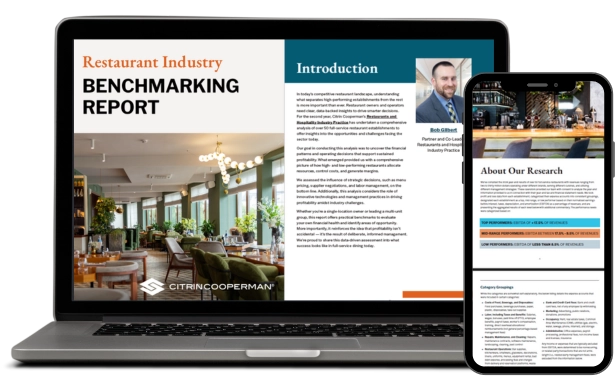Leveraging Data Analytics to Boost Restaurant Performance
There has been an incredible impetus for the shift toward cloud transformation and implementing artificial intelligence (AI) tools across industries, and restaurants are no exception. As restaurant owners and management grapple with cybersecurity and operational efficiency, many are utilizing sophisticated software strategically to remain competitive.
The motivation for restaurant decision makers to participate in this type of digital transformation is largely driven by risk aversion and competition — they're recognizing what they need to do to stay current in a turbulent market. Cloud-based software has enabled small to midsize organizations to leverage the same technology that enterprise organizations have, allowing more businesses to participate.
Integrating data analytics with restaurant technology is essential for maximizing its potential. Technologies like cloud computing, machine learning, and AI can enhance data processing and analysis. For instance, AI can predict customer preferences based on historical data, while cloud computing enables real-time data access and collaboration across various locations. This integration ensures that data analytics becomes a seamless part of restaurant operations. A structured data layer, often built as a data warehouse, is the foundation for any meaningful analytics or AI initiative. It brings together data from a point of sale (POS) system, inventory, labor scheduling, delivery platforms, and customer feedback into a single, organized system. This enables consistent reporting, cross-functional insights, and scalable decision-making.
This article explores the considerations for implementing data analytics to improve your restaurant’s performance.
Key Data Sources
Several key data sources can feed into your restaurant's analytics efforts including:
-
Point of Sale (POS) Systems
POS systems hold an incredible amount of information for restaurants, tracking sales transactions, providing detailed information on what items are selling, peak hours, and average transaction values. This data is crucial for understanding customer behavior and preferences. For instance, analyzing POS data can reveal which dishes are most popular during meal shifts, days of the week, or even seasons, helping restaurants optimize their menu and pricing strategies. Furthermore, POS data can uncover sales trends and identify opportunities for promotions or upselling.
-
Customer Feedback
Online reviews, surveys, and social media interactions offer insights into customer satisfaction and areas for improvement. Customer feedback is vital for understanding what diners love and where there’s room for improvement. By systematically collecting and analyzing this feedback, restaurants can make informed decisions about menu changes, service enhancements, and marketing strategies. Moreover, responding to feedback can improve customer relationships and brand reputation.
-
Inventory Management Systems
These systems help manage food and beverage costs by giving an operator real-time visibility into ingredient-level spending and recipe profitability. They integrate with POS and vendor invoices to track actual versus theoretical costs, helping identify waste, over portioning, or pricing issues. With automated reporting and analytics, you can make faster, data-driven decisions to protect your margins and improve operational efficiency.
-
Employee Performance Metrics
Analyzing staff productivity and efficiency can help optimize labor costs and improve service quality. Employee performance data provides insights into scheduling, training needs, and overall productivity. For example, tracking metrics such as table turnover rates and order accuracy can highlight areas where staff may need additional training or support. Furthermore, data-driven scheduling can ensure that staffing levels align with customer demand, reducing labor costs while maintaining high service standards.
The Benefits
Leveraging data analytics offers numerous benefits for restaurant owners, enabling them to make informed decisions that enhance performance and profitability.
Enhanced Customer Experiences
By analyzing customer feedback and preferences, restaurants can tailor their offerings to better meet customer needs. This might involve adjusting menu items, refining service protocols, or personalizing marketing efforts. For example, if data shows a high demand for vegetarian options, a restaurant might expand its plant-based menu to attract more customers.
Strategic Menu Development
Understanding which items are most popular can guide menu development decisions. Data can reveal trends and preferences, helping restaurants design menus that appeal to their target audience. This not only boosts sales but also enhances customer satisfaction by offering dishes that diners love. Additionally, data insights can help with pricing strategies, allowing restaurants to balance profitability with customer value.
Improved Operational Efficiency
Data analytics can pinpoint inefficiencies in operations, such as overstaffing during slow periods or excessive food waste. By addressing these issues, restaurants can streamline their processes, reduce costs, and improve profitability. For instance, analyzing sales patterns can help optimize staff schedules, ensuring that the right number of employees are working during peak times. Moreover, data-driven insights can guide energy usage and equipment maintenance, reducing operational costs further.
Implementing Data Analytics in Your Restaurant
Implementing data analytics in your restaurant can seem like a daunting undertaking. While these investments can be costly, selecting and implementing the right tools for your restaurant the first time will increase your return on investment and enhance profitability in the long run.
-
Invest in the Right Tools
Choose a robust POS system and inventory management software that can track and analyze key metrics. These tools should be integrated seamlessly with your existing operations and provide detailed reports that are easy to interpret. Investing in the right technology is crucial for effective data — this is not an area to cut corners. Consider tools that offer real-time reporting and customizable dashboards, allowing you to focus on the metrics that matter most to your business.
Business intelligence (BI) tools like Power BI allow operators to visualize performance across locations, shifts, and menu categories. AI can take this further by identifying patterns and predicting future outcomes.
Examples:- BI: A dashboard shows brunch sales are strong, but labor costs are high, prompting a schedule change.
- AI: A model predicts which menu items will underperform next quarter based on seasonality and past sales.
- Compare and dissect performance across locations
- Track actual vs. theoretical food costs
- Optimize workforce needs and scheduling
- Understand customer behavior across dine-in, takeout, and delivery
-
Train Your Team
These investments are prone to failure if businesses don’t get their employees involved and don’t invest the time and dollars in training their staff. Regular training should include understanding how to input data accurately and how to interpret the analytics reports to make informed decisions. Training should emphasize the importance of data accuracy and consistency, as these are critical for reliable analysis. Additionally, encourage a data-driven culture where employees understand the value of analytics in improving their work and overall restaurant performance.
-
Regularly Review Data
Once you have the tools implemented to produce concise relevant data, make it a habit to regularly review and analyze your data. Schedule regular meetings to discuss findings with your team and brainstorm strategies for improvement. This ongoing process will ensure that your restaurant continues to benefit from data-driven insights. Regular data reviews help keep your strategies dynamic and responsive to changing trends. Encourage open communication and collaboration during these reviews, as diverse perspectives can lead to innovative solutions and improvements.
As analytics tools evolve, restaurants can more easily converse with their data. Using natural language interfaces, operators can now ask questions like:
- “Which locations had the highest labor cost last week?”
- “What’s the trend in vegetarian orders over the past 6 months?”
- “What’s our most profitable menu item during lunch?”
- “Are we seeing more repeat customers from DoorDash or Uber Eats?”
This makes data accessible to non-technical users and accelerates decision-making across the organization.
How Citrin Cooperman Can Help
Data analytics can help restaurants address market volatility in very unique ways, making it accessible for them to more effectively manage the impact of increased costs, understand margin implications, and turn that insight into action. Citrin Cooperman’s Restaurants and Hospitality Industry Practice, complemented by our Digital Services Practice, can help businesses realize impactful benefits from the deployment of data analytics tools. When you engage Citrin Cooperman, the outcome isn’t just a report — it’s a purpose-built, scalable analytics platform that includes:
- Planning and strategy definition and implementation of a structured data layer integrating all key systems
- Dashboards tailored to your KPIs (e.g., food cost, labor efficiency, customer sentiment)
- AI models that forecast demand, optimize staffing, and identify margin opportunities
- Training and support to ensure your team can act on the insights
For more information on how we can help your restaurant business thrive, contact Robert Gilbert or your Citrin Cooperman advisor.
Explore the Restaurant Industry Benchmarking Report

For more insights into the trends and challenges facing restaurants in today’s market, access our 2025 Restaurant Industry Benchmarking Report.
For the second year, Citrin Cooperman analyzed over 50 restaurants to determine the influence of strategic decisions, such as menu pricing, supplier negotiations, and labor management, on the bottom line.
Latest Article Cards

Uncharted No More: Fees and Carried Interest in the Independent Sponsor Sector
Read More

Improving Customer Experiences: The Case for Migrating to Azure
Read More

Shades of Grey: Disclosures Under Section 6103(e)(8)
Read More

Cannabis Industry Alert: Executive Order Directs Completion of Marijuana Rescheduling Rulemaking
Read More


